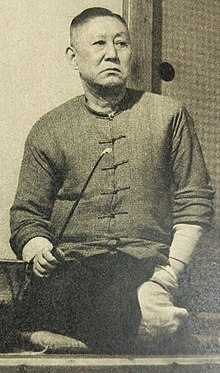Hyakken Uchida
Hyakken Uchida | |
|---|---|
 | |
| Native name | Nội điền bách gian |
| Born | Eizō Uchida ( nội điền vinh tạo ) May 29, 1889 Okayama,Okayama,Japan |
| Died | April 20, 1971(aged 81) Tokyo, Japan |
| Occupation | Writer andacademic |
| Nationality | Japanese |
Hyakken Uchida(Nội điền bách gian[1],Uchida Hyakken,May 29, 1889 – April 20, 1971)was a Japanese author and academic.
Biography[edit]

Uchida was born inOkayamato a family of sake brewers whose business later went bankrupt. His real name isEizo Uchida( nội điền vinh tạoUchida Eizō). He became a pupil ofNatsume Sōsekiin 1911. He graduated fromTokyo University(Tokyo Imperial University) in 1914. He became professor of German atImperial Japanese Army Academyin 1916. He later taught atHosei University(Tokyo). He is the main subject ofAkira Kurosawa's last film,Madadayo(まあだだよ).His novel,Disk of Sarasate(サラサーテの bàn,Sarasāte no ban)is the inspiration for the film,Zigeunerweisen.He is the author of more than fifteen volumes of writings includingI am a Cat: The Fake Version(Nhạn tác ngô bối は miêu である,Gansaku wagahai ha neko de aru),andGates Close at Dusk(Nhật một bế môn,Nichibotsu heimon).In Japan he is well known as a passionaterailfanand he made some works on railway travel.[2]Though a great literary figure in Japan, he currently only has one book translated into English:Realm of the Dead( minh đồMeido). That volume also includes the collectionTriumphal Entry intoRyojun(Ryojun Nyujōshiki(Lữ thuận nhập thành thức)). "Small Round Things", a translated excerpt from another collection,Jottings from the Goblins' Garden(Hyakkien Zuihitsu(Bách quỷ viên tùy bút)), appeared in the JAL inflight magazineSkywardin January 2006. He had two sons and three daughters.
Bibliography[edit]
Novels[edit]
- Meido(Minh đồ)(Realm of the Dead) (1922)
- Ryojun Nyujōshiki(Lữ thuận nhập thành thức)(1934)
- Tokyo Nikki(Đông kinh nhật ký)(The first appearance of theTokyo NikkiinOka no Hashi(Khâu の kiều).) (1939)
- Nanzanju(Nam sơn thọ)(The first appearance of theNanzanjuinKiku no Ame(Cúc の vũ).) (1939)
- Yanagi Kenkō no Shōkan(Liễu kiểm giáo の tiểu nhàn)(The first appearance of theYanagi Kenkō no ShōkaninFune no Yume(Thuyền の mộng).) (1941)
- Gansaku Wagahai wa Neko de Aru(Nhạn tác ngô bối は miêu である)(1950)
- Sarasāte no ban(サラサーテの bàn)(The first appearance of theSarasāte no baninJissetsu Sōheiki(Thật thuyết thảo bình ký).) (1951)
- Ahō Ressha(A phòng liệt xa)(1952–1956)
Essays[edit]
- Hyakkien Zuihitsu(Bách quỷ viên tùy bút)(1933)
- Manuke no Jitsuzai ni Kansuru Bunken(Gian bạt けの thật tại に quan する văn hiến)(1933)
- Zoku Hyakkien Zuihitsu(Tục bách quỷ viên tùy bút)(1934)
- Daihinchō(Đại bần trướng)(1941)
- Gochisōchō(Ngự trì tẩu thiếp)(1946)
- Jissetsu Sōheiki(Thật thuyết thảo bình ký)(1951)
- Nora ya(ノラや)(1957)
- Nichibotsu Heimon(Nhật một bế môn)(1971)
Children's literature[edit]
- Ō-sama no Senaka(Vương dạng の bối trung)(1934)
Diary[edit]
- Hyakkien Nikkichō(Bách quỷ viên nhật ký thiếp)(1935)
- Hyakkien Nikkichō(Tục bách quỷ viên nhật ký thiếp)(1937)
- Tokyo Shōjin(Đông kinh thiêu tẫn)(1955)
Haiku[edit]
- Hyakkien Haikuchō(Bách quỷ viên bài cú thiếp)(1934)
- Hyakkien Haiku(Bách quỷ viên bài cú)(1943)
Film[edit]
- Roppa no Hōjiro Sensei(ロッパの頬 bạch tiên sinh),Toho,1939), starringRoppa Furukawa.
- Zigeunerweisen(ツィゴイネルワイゼン)(Toho, 1980), directed bySeijun Suzuki,starringYoshio Harada,original novelSarasāte no ban.
- Madadayo(まあだだよ)(Daiei,1993), directed byAkira Kurosawa,starringTatsuo Matsumura.
See also[edit]
Notes[edit]
- ^His name Hyakken is normally written bách nhàn, the latter character (which cannot be displayed by some computers) being a variant of gian with nguyệt rather than nhật inside môn.
- ^SeeAhō ressha(Japanese).
External links[edit]
- Hyakken UchidaatIMDb
- Hyakken Uchida's grave
- Hyakken Uchidaat J'Lit Books from Japan(in English)
- Synopsis ofRealm of the Dead(Meido)at JLPP (Japanese Literature Publishing Project)(in English)
